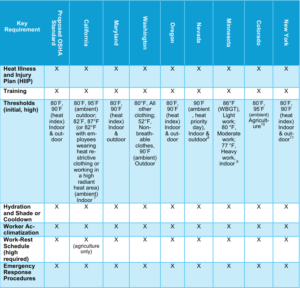According to the Bureau of Labor Statistics, 479 workers in the United States died from exposure to environmental heat between 2011 to 2022 – an average of 40 fatalities per year. The Occupational Safety & Health Administration (OSHA) states that 50-70% of the outdoor fatalities occur in the first few days of working in warm or hot environments, because the body is not acclimatized to the heat.1
Climate change has intensified heat risks for workers, leading to increased heat-related illnesses and deaths – especially in physically demanding jobs in extreme conditions.2 More than 70% of the global workforce is at risk from severe heat. As the climate changes, average and extreme temperatures are increasing, along with heat waves.3
To address this, OSHA issued a new federal standard for Heat Injury and Illness Prevention, which was proposed on August 30, 2024 and passed the comment period ending January 14, 2025. The American Industrial Hygienist Association (AIHA) commented with their recommendations on the proposed standard on November 5, 2024.
OSHA is looking to finalize the new rule to help prevent workplace heat-related injuries and illnesses in both indoor and outdoor environments and has scheduled a virtual public hearing on June 16, 2025. This hearing will allow stakeholders to present their views and suggestions directly to OSHA, further informing them of the development of the final rule. It applies to construction, general industry, maritime, and agriculture sectors, unless subject to an exception (i.e., work where employees are unlikely to be exposed to extended high-heat conditions, like in an air-conditioned office).
State-Mandated Heat Illness Prevention Requirements
Currently, OSHA can enforce heat-related hazards under the General Duty clause which requires employers to provide a workplace free from recognized hazards that are likely to cause death or serious harm. California, Maryland, Washington, Oregon, Nevada, Minnesota, Colorado and New York have already adopted heat-related regulatory standards to protect workers. Other states, like Texas and Virginia, provide recommended guidelines for preventing worker heat injury and illness. On the next page we present a comparison between the key requirements in the new proposed OSHA Standard for Heat Injury and Illness Prevention and current state mandates.
HETI Industrial Hygiene Services
HETI has Certified Industrial Hygienists across the U.S. available to help clients navigate through heat injury and illness prevention issues, including compliance. We have extensive experience in Heat Injury and Illness Plan (HIIP) development, heat monitoring techniques, risk assessments, emergency response procedures, and employee training experience – with a variety of industries, including manufacturing, oil and gas, and government.
References:
1OSHA – Overview: Working in Outdoor and indoor Heat Environments
2OSHA – Heat Injury and Illness Prevention in Outdoor and Indoor Work Settings Rulemaking
3 EPA – Climate Change and the Health of Workers
4 https://www.bdlaw.com/publications/osha-proposes-new-heat-injury-and-illness-prevention-standard/
5Trump Administration’s ‘Regulatory Freeze Pending Review’ Pauses OSHA’s Rulemaking on Heat Illness and
Emergency Response
6“Chill For Now”—Trump Administration Pauses Heat Hazard Rule, But Contractors Still Face Compliance Issues
7California Indoor Heat Protections approved to go into effect
8R131-24
9MNOSHA Heat Stress Guide
10 HOUSE BILL 25-1286
11 S1604C
To find out more about this and other HETI industrial hygiene services, please contact us.
Renee Cowell, CIH, CSP
Senior Industrial Hygienist
Phone: 978.263.4044
development@hetiservices.com
HETI at AIHA CONNECT 2025
Meet the HETI team at Booth #734 during the American Industrial Hygiene Association
Annual Conference & Expo, May 19-21 in Kansas City, Missouri
HETI’s Dr. Daniel Farcas, CIH, CSP, CHMM will teach the course,
PDC 406: CIH Exam Equations Visually Explained,
on Sunday, May 18 from 8:00 AM to 5:00 PM
at the Kansas City Convention Center, Room 2101

